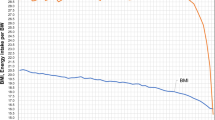Abstract
Objective: To determine the prevalence of chronic energy deficiency (CED) and associated mortality risk in a cohort of adult Nigerians followed from 1992 to 1997.
Research methods and procedures: The data for this investigation were derived from an international collaborative study on chronic diseases in populations of the African diaspora. Body mass index (BMI) was used to define three grades of CED in 4061 men and women aged 25 years and older: Grade I (mild CED) as BMI 17.5–18.4, Grade II (moderate CED) as BMI 16.0–17.4, and Grade III (severe CED) as BMI<16.0 and BMI ≥18.5 was considered normal. The odds of mortality associated with differing grades of CED was estimated with logistic regression analysis.
Results: The prevalence of CED (BMI<18.5) increased from 14.3% in 1992 to 19.6% in 1997, both genders combined. The prevalence of CED was similar for both sexes in 1992 (14%) but increased to 22.4% in men and 17.4% in women by 1997. The prevalence of CED was 8.5%, 7.6 and 3.4 for Grades I, II and III, respectively. Two hundred and seven deaths occurred during the follow-up period. The mortality rate for the 5.5 y of follow-up was 5.1% (207/4061). The odds ratios (95% Cls) for all cause mortality were 1.4 (0.5, 3.8), 2.4 (1.2, 4.9) and 2.5 (1.0, 6.2), respectively, for CED grades I, II and III adjusting for age and sex.
Conclusion: Under nutrition is an increasing problem in Nigerian men and women. The economic reforms (structural adjustment program (SAP)) introduced in 1986 in combination with the continued economic woes brought on by political instability, corruption and nepotism have been advanced by several investigators as the main factors in the growing problem of inadequate calorie intake. Intervention strategies both at the government and private sectors are urgently needed to increase food availability.
Sponsorship: This work was supported by grants from the National Institutes of Health (HL 45508, HL 47910, HL 53353).
Similar content being viewed by others
Author information
Authors and Affiliations
Contributions
Guarantor: Dr Charles N. Rotimi
Contributors: Charles Rotimi contributed to the study design, performed statistical analysis and drafted the paper. Richard Cooper, Jay Kaufman, Ike Okosun contributed to the study design, data management and critically revised the paper. Lanre Johnson, Eme Owoaje, Taiwo Lawoyin, Michael Asuzu and Adebowale Adeyemo supervised the study, contributed to data management and critically revised the paper.
Corresponding author
Rights and permissions
About this article
Cite this article
Rotimi, C., Okosun, I., Johnson, L. et al. The distribution and mortality impact of chronic energy deficiency among adult Nigerian men and women. Eur J Clin Nutr 53, 734–739 (1999). https://doi.org/10.1038/sj.ejcn.1600842
Received:
Revised:
Accepted:
Published:
Issue Date:
DOI: https://doi.org/10.1038/sj.ejcn.1600842
- Springer Nature Limited
Keywords
This article is cited by
-
Multilevel analysis of undernutrition and associated factors among adolescent girls and young women in Ethiopia
BMC Nutrition (2022)
-
Assessment of nutritional status using anthropometric variables by multivariate analysis
BMC Public Health (2019)
-
What Characterises Women Vulnerable to Chronic Energy Deficiency?
Social Indicators Research (2009)




